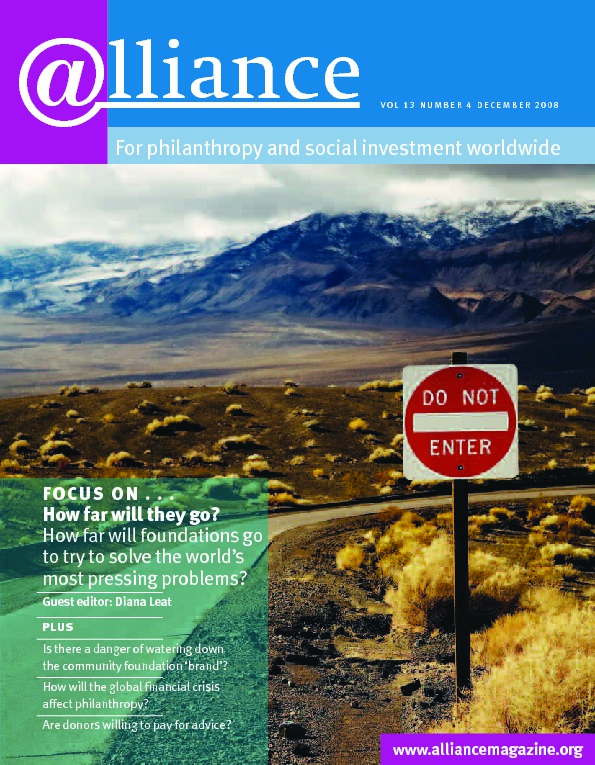 When Joseph Rowntree set up his charitable trust in 1904, he believed that ‘if the enormous volume of philanthropy of the present day were wisely directed, it would … in the course of a few years, change the face of England’.
When Joseph Rowntree set up his charitable trust in 1904, he believed that ‘if the enormous volume of philanthropy of the present day were wisely directed, it would … in the course of a few years, change the face of England’.
So he directed that his trust should be wound up in 1939, expecting that by then the job would have been completed. None the less, he made allowances for its possible continuation, which is why we are here now. But trustees are still required to sit down at the end of each decade to consider whether the Joseph Rowntree Charitable Trust (JRCT) should spend its capital and close down. It is useful to speculate whether there are circumstances in which it might.
There are several ‘little local difficulties’. Chief of these is inertia: we have developed a pattern of existence and, by definition, shutting up shop runs counter to it. Trustees would certainly feel reluctant to put their staff on the dole: not much of a reward for dedicated service. And what of current grantees, some of whom have been with the Trust for many years and whose work would almost certainly cease if the Trust ceased? Then there is the natural modesty of trustees who recognize their human fallibility: while the Trust continues, failures or omissions of the past can be rectified in the future, if not by them then by their successors, whereas a decision to spend down is once-and-for-all with no second thoughts.
Harder hearts would say that trustees are not modest at all. They cannot conceive of the social landscape without their foundation in it – hence the fact that we don’t seriously consider the argument for spending according to perceived current need as opposed to spending to preserve the endowment.
A less optimistic view of the world
On a grander scale, we think differently about the world now from the way they did a hundred years ago. Up to the First World War, people believed that society was perfectible. Revolution, by which society could be radically changed and for the better, was a dream waiting to be realized: hence the enthusiasm for the Soviet Union, which persisted throughout the 1930s, and the romanticization of Maoism, still prevalent in the 1970s. It took time for us to comprehend the gross abuses which underpinned the realities of communism. Meanwhile, we saw technical innovation grow exponentially, offering new ways of addressing what were now perceived to be global rather than national problems; but we also saw famine and slaughter on a scale unimaginable at any previous time.
We have lost the optimism of Joseph Rowntree and his contemporaries which assumed that a serious consideration of the ‘root causes’ of poverty, famine or whatever would produce permanent solutions. We live in a post-modern world in which there is no single ideal, where problems may have multiple solutions, or none, and in which the ‘solution’ itself may define the next problem. Experience shows that there are whole areas in our lives we simply do not know how to control: finance, for example. History tells us that general consensus, even within the scientific community, which prides itself on rationality, can sometimes be dramatically wrong. In these circumstances, you have to be self-confident, moving towards foolhardy, verging on reckless, to engage in a one-off project that uses your entire endowment.
Yet there are some foundations that have decided to spend out. There are different rationales for this, which range from a straight diktat by the founding philanthropist to a perception that, without the urgency of a time limit, foundations simply become part of the furniture in the room whose furnishings they are seeking to change. One of the pessimistic questions aired at the last EFC conference in Istanbul was whether, for all their money, foundations actually make any difference at all.
The contrary view, however, is that there are no ‘once-and-for-all solutions’ and that, when the grand project is over, the money spent, and the foundation shut down, the rest of us will be left to pick up the pieces, to fill the vacuum which nature abhors, for social change is a complex process which continues to evolve beyond the fixed date of a foundation’s closure.
An exercise in risk assessment
But might there be a case for at least partly spending down while not fully closing? That is an exercise in risk assessment. If, for example, your foundation wishes to promote peace – as JRCT does – a unique opportunity has presented itself in the planned refurbishment of Britain’s nuclear deterrent. If Britain decides not to proceed, it will effectively become a non-nuclear power, a decision that is unlikely to be later reversed. The project – to persuade the government of the day not to upgrade Trident – is also time-limited, which again makes it attractive. So what are the risks?
First, is it a realistic project – and is it charitable? Cynics will say that the decision has already been taken and Aldermaston is actively preparing to do the work, while lawyers might argue that to promote the dismantling of our most pernicious weapon of war is a political not a charitable act. (Why should the promotion of peace not be accounted charitable?) But for the sake of argument let us set these issues aside …
Second, given the apathy of most people towards the British nuclear deterrent – with a majority in favour of keeping it – what are the costs of a campaign to change public attitudes and what are the chances of success? Alternatively, since parliament can sometimes be persuaded to legislate against prevailing public opinion, what are the costs of a campaign to lobby the government? And, since we are starting now with an election in the offing, which party will we target?
These are imponderables, for which we will never manage better than an informed guess, so our risk assessment is vague at best. But let us suppose that we are told that £50 million (about 30 per cent of JRCT’s current endowment) would give us a fair chance of success, what then? We would want to know what ‘fair’ means – and if we set aside, say, £60 million instead of £50 million, would our chances improve? Experience tells us that, even with the best campaigns, coordinated by people with a lifetime of experience, things can go wrong. So, imponderables once more.
Counting the cost
If, however, we decide that the project stands, let us say, a 70 per cent chance of success, we then have to count the cost – not of failure, though that must come into the reckoning at some point – but of the damage to the rest of our programme. Thirty per cent loss of endowment means 30 per cent loss of income … or we guess it does. But none of us are financial wizards and, though we can make short-term projections, it is impossible to know what the economy will be doing in, say, 20 years. (Or even in one: which of us a year ago foresaw the current financial meltdown and took evasive action to preserve our endowments?) So the best we can say is that we would expect to have less money to spend – but on what?
In general, JRCT responds to applications rather than creating its own programme of work – so we cannot know what applicants we will regretfully refuse because of our diminished income. All we know for certain is that we are currently over-subscribed and therefore likely in future to turn down yet more ideas that we would otherwise have liked to support. But it is impossible to rate these notional applications against the actual project we are currently contemplating.
(Incidentally, this is the argument for spending down by attrition. We regularly spend less on current applications than we would like because our grantmaking is limited by our sustainable income policy which aims to maintain the value of our endowment; in short, we mortgage a present (known) good in favour of a future (unknown) good. The alternative and, arguably, more logical policy would be to spend now according to perceived need.)
But to return to the project in hand. Let us suppose we opt for an anti-nuclear campaign – and fail. What then? We know that we will have wasted our money – or do we? Though we have been unsuccessful today, the campaign may yet have sown the seeds of nuclear disarmament at a future date: funding in the peace field is notoriously a long haul.
But what, meanwhile, of the reputation of a foundation that has so publicly and expensively backed a loser? This is one of the few risks that can be discounted. The foundation does not need public approbation to carry out its functions and can continue, albeit with a smaller purse, as it did before. Indeed, a cynic might argue that its reputation would be enhanced: JRCT has long been known as a radical foundation, willing to take risks, and its heroic support for a lost cause might increase its standing!
But when all is said and done, the uncertainties of the project are a fair guarantee against its adoption. Of course, we can offset some of the risks, find partners to share the financial burden and so on. But the UK peace field is not large and JRCT is one of the bigger players. It would be a lot of eggs to put in one basket and so wise counsel will shake its head and the proper humility of trustees will opt for caution. Stanley Baldwin would approve: ‘Safety first!’ It is always safer to do nothing …
But what would Joseph Rowntree have done? Well, time changes all things, but in 1904 he planned that his charity would root out the causes of evil and after 35 years shut up shop and go home.
Peter Coltman is a Trustee of JRCT. Email pcoltman@gn.apc.org


Comments (0)